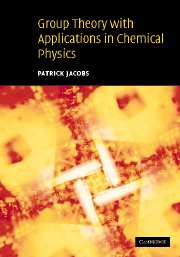Book contents
- Frontmatter
- Contents
- Preface
- Notation and conventions
- 1 The elementary properties of groups
- 2 Symmetry operators and point groups
- 3 Matrix representatives
- 4 Group representations
- 5 Bases of representations
- 6 Molecular orbitals
- 7 Crystal-field theory
- 8 Double groups
- 9 Molecular vibrations
- 10 Transitions between electronic states
- 11 Continuous groups
- 12 Projective representations
- 13 Time-reversal symmetry
- 14 Magnetic point groups
- 15 Physical properties of crystals
- 16 Space groups
- 17 Electronic energy states in crystals
- 18 Vibration of atoms in crystals
- Appendices
- References
- Index
2 - Symmetry operators and point groups
Published online by Cambridge University Press: 10 December 2009
- Frontmatter
- Contents
- Preface
- Notation and conventions
- 1 The elementary properties of groups
- 2 Symmetry operators and point groups
- 3 Matrix representatives
- 4 Group representations
- 5 Bases of representations
- 6 Molecular orbitals
- 7 Crystal-field theory
- 8 Double groups
- 9 Molecular vibrations
- 10 Transitions between electronic states
- 11 Continuous groups
- 12 Projective representations
- 13 Time-reversal symmetry
- 14 Magnetic point groups
- 15 Physical properties of crystals
- 16 Space groups
- 17 Electronic energy states in crystals
- 18 Vibration of atoms in crystals
- Appendices
- References
- Index
Summary
Definitions
Symmetry operations leave a set of objects in indistinguishable configurations which are said to be equivalent. A set of symmetry operators always contains at least one element, the identity operator E. When operating with E the final configuration is not only indistinguishable from the initial one, it is identical to it. A proper rotation, or simply rotation, is effected by the operator R(φn), which means “carry out a rotation of configuration space with respect to fixed axes through an angle φ about an axis along some unit vector n.” The range of φ is − π < φ ≤ π. Configuration space is the three-dimensional (3-D) space ℛ3 of real vectors in which physical objects such as atoms, molecules, and crystals may be represented. Points in configuration space are described with respect to a system of three space-fixed right-handed orthonormal axes x, y, z, which are collinear with OX, OY, OZ (Figure 2.1(a)). (A right-handed system of axes means that a right-handed screw advancing from the origin along OX would rotate OY into OZ, or advancing along OY would rotate OZ into OX, or along OZ would rotate OX into OY.) The convention in which the axes x, y, z remain fixed, while the whole of configuration space is rotated with respect to fixed axes, is called the active representation.
Information
- Type
- Chapter
- Information
- Group Theory with Applications in Chemical Physics , pp. 23 - 52Publisher: Cambridge University PressPrint publication year: 2005
